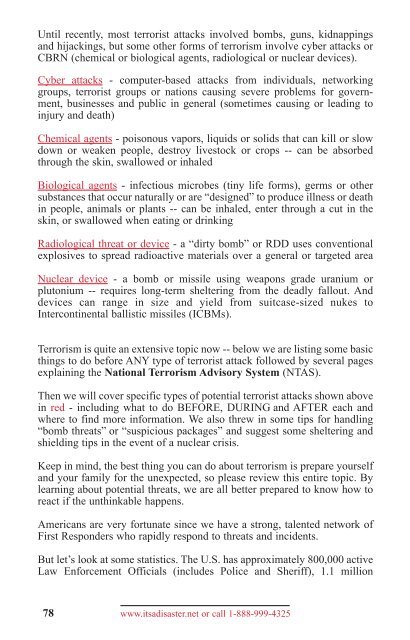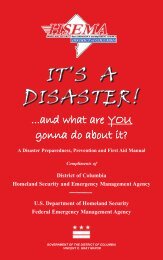disaster 5th 1108_5th ed 2011 - Homeland Security and Emergency ...
disaster 5th 1108_5th ed 2011 - Homeland Security and Emergency ...
disaster 5th 1108_5th ed 2011 - Homeland Security and Emergency ...
Create successful ePaper yourself
Turn your PDF publications into a flip-book with our unique Google optimized e-Paper software.
Until recently, most terrorist attacks involv<strong>ed</strong> bombs, guns, kidnappings<br />
<strong>and</strong> hijackings, but some other forms of terrorism involve cyber attacks or<br />
CBRN (chemical or biological agents, radiological or nuclear devices).<br />
Cyber attacks - computer-bas<strong>ed</strong> attacks from individuals, networking<br />
groups, terrorist groups or nations causing severe problems for government,<br />
businesses <strong>and</strong> public in general (sometimes causing or leading to<br />
injury <strong>and</strong> death)<br />
Chemical agents - poisonous vapors, liquids or solids that can kill or slow<br />
down or weaken people, destroy livestock or crops -- can be absorb<strong>ed</strong><br />
through the skin, swallow<strong>ed</strong> or inhal<strong>ed</strong><br />
Biological agents - infectious microbes (tiny life forms), germs or other<br />
substances that occur naturally or are “design<strong>ed</strong>” to produce illness or death<br />
in people, animals or plants -- can be inhal<strong>ed</strong>, enter through a cut in the<br />
skin, or swallow<strong>ed</strong> when eating or drinking<br />
Radiological threat or device - a “dirty bomb” or RDD uses conventional<br />
explosives to spread radioactive materials over a general or target<strong>ed</strong> area<br />
Nuclear device - a bomb or missile using weapons grade uranium or<br />
plutonium -- requires long-term sheltering from the deadly fallout. And<br />
devices can range in size <strong>and</strong> yield from suitcase-siz<strong>ed</strong> nukes to<br />
Intercontinental ballistic missiles (ICBMs).<br />
Terrorism is quite an extensive topic now -- below we are listing some basic<br />
things to do before ANY type of terrorist attack follow<strong>ed</strong> by several pages<br />
explaining the National Terrorism Advisory System (NTAS).<br />
Then we will cover specific types of potential terrorist attacks shown above<br />
in r<strong>ed</strong> - including what to do BEFORE, DURING <strong>and</strong> AFTER each <strong>and</strong><br />
where to find more information. We also threw in some tips for h<strong>and</strong>ling<br />
“bomb threats” or “suspicious packages” <strong>and</strong> suggest some sheltering <strong>and</strong><br />
shielding tips in the event of a nuclear crisis.<br />
Keep in mind, the best thing you can do about terrorism is prepare yourself<br />
<strong>and</strong> your family for the unexpect<strong>ed</strong>, so please review this entire topic. By<br />
learning about potential threats, we are all better prepar<strong>ed</strong> to know how to<br />
react if the unthinkable happens.<br />
Americans are very fortunate since we have a strong, talent<strong>ed</strong> network of<br />
First Responders who rapidly respond to threats <strong>and</strong> incidents.<br />
But let’s look at some statistics. The U.S. has approximately 800,000 active<br />
Law Enforcement Officials (includes Police <strong>and</strong> Sheriff), 1.1 million<br />
78 www.itsa<strong>disaster</strong>.net or call 1-888-999-4325





